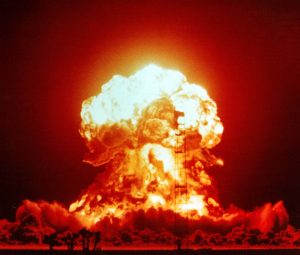As submarines, bombers, and ballistic missiles age, and as the U.S. armed forces flourish the long knives over budgetary matters, the future of the nuclear triad has come under scrutiny. The Obama administration released a new Nuclear Posture Review in 2010 and revised its Nuclear Employment Strategy last June. Think-tank analyses abound. While vowing to seek additional cutbacks to the U.S. and Russian arsenals and reduce the part nuclear weapons play in U.S. national security strategy, the administration also affirms that it will retain the triad of nuclear-powered ballistic-missile submarines (SSBNs), manned bombers, and intercontinental ballistic missiles (ICBMs).
Fixing its strategic gaze on Russia, however, risks anchoring Washington in the Cold War past. The triad aimed at deterring the Soviet Union, a peer opponent boasting a massive atomic arsenal. But the world has entered a second nuclear age typified less by deterrence between nuclear-armed alliances than by competition among states at very different places in their nuclear lives. Multiple nuclear trajectories translates into a more complex strategic setting. Concentrating exclusively on Russia distracts from a comprehensive survey of that setting, and potentially leaves U.S. nuclear strategy out of phase with changing times.
Making strategy, then, promises to be a more intricate enterprise in the second nuclear age than the first. Think about it. The United States and Russia remain the biggest nuclear-weapon states by a sizable margin, but their inventories are on the downslope owing to arms-control accords bearing names like START and New START. Washington intends to seek further reductions, further narrowing the Russian and American margins of supremacy over lesser nuclear powers. Great Britain and France, meanwhile, are struggling to remain nuclear-weapon states. Replacing the Royal Navy’s Trident SSBN force has proved such a pricey undertaking that the rest of the navy is shrinking to boutique proportions to pay for it.
So much for the nuclear old timers. China has embarked on a sweeping overhaul to its nuclear deterrent, for instance by putting to sea its first viable SSBN fleet — that is, its first invulnerable second-strike force. That makes Beijing a de facto newcomer to the nuclear-weapons club. India and Pakistan fielded modest arsenals after the 1998 nuclear tests. North Korea staged a small-scale nuclear breakout, while Iran entertains atomic aspirations — as yet unfulfilled — of its own. And so on. Variety rules.
It’s imperative, consequently, to think ahead about how nuclear old timers on the decline will make and execute strategy. Equally critical is to envision the strategies new entrants to the nuclear club — entrants with smaller, more vulnerable forces than those maintained by established powers — will deploy to safeguard their interests in a bareknuckles world. Coping with asymmetry and the new, shifting geometry of deterrence is the challenge before the U.S. military.
That imperative should shape the nation’s nuclear forces. Does America need all three legs of the triad to protect itself in the second nuclear age? Covert SSBNs remain the mainstay of deterrence vis-á-vis peer competitors. Is an undersea monad enough? Partisans of air power maintain that manned bombers can signal resolve in a crisis in a way SSBNs, which cruise the depths unseen, never can. This makes sense. Does the aerial component supply enough value in the second nuclear age to repay the investment? And what about ICBMs? The missile force looks like the most expendable leg of the triad. ICBMs duplicate the SSBN fleet’s second-strike capacity, except they’re more vulnerable to enemy counterstrikes. Nor are they particularly useful for telegraphing steadfastness.
Such matters are worth mulling over. The triad — which after all is nothing more than a set of policy implements — shouldn’t be held sacrosanct just to please advocates in the U.S. Navy and Air Force. If all three legs are critical in the second nuclear age, let’s keep them. If not, let’s dispose of excess capacity. Assembling the right toolkit is the trick to executing strategy in all ages. So is discarding worn-out tools.

































